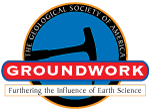Abstract View
Volume 27 Issue 10 (October 2017)
GSA Today
Article, pp. 36–37 | Full Text | PDF (198KB)
 |
| Search GoogleScholar Search GSA Today |
GROUNDWORK:
Harnessing an Effective Geoscience Curriculum for Students with Autism Spectrum Disorder
1 Education Department, Touro College, New York, New York 10023, USA
2 Biology Department, Touro College, New York, New York 10023, USA
Introduction
There is a growing awareness of the need to help individuals with autism survive the rigors of the classroom. On average, one in 68 students is diagnosed with autism spectrum disorder (ASD) annually (Autism Speaks: “Facts about Autism,” n.d.). ASD is a large spectrum, ranging from nonverbal individuals who respond minimally to intervention to individuals who “lose their diagnosis” (Sarris, 2016). A loss of diagnosis occurs when individuals are nearly indistinguishable from their peers; some individuals even use their savant-like qualities to compensate for their challenges (Winter-Messiers and Herr, 2007; Wisconsin Medical Society, 2016). ASD causes challenges with communication, knowledge of socially appropriate behaviors, and sensory regulation (Autism Speaks: “DSM-5 Diagnostic Criteria,” n.d.). Individuals with autism are said to attempt to cope by engaging in self-stimulatory behaviors. These are behaviors that provide sensory input, which include rocking, flapping hands, and rubbing hands. These challenges can be mitigated when building on the strengths of individuals with ASD, which can include science (Education Insider, 2015). One area of difficulty for students with autism is the hidden curriculum—the accepted attitudes and behaviors not part of the formal curriculum but necessary for social interactions (Myles and Simpson, 2001). Teachers can build on areas of strength while utilizing science to teach the hidden curriculum.
Manuscript received 16 Nov. 2016; Revised manuscript received 10 May 2017; Manuscript accepted 21 June 2017
10.1130/GSATG325GW.1
©2017, The Geological Society of America.
